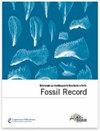下载PDF
{"title":"The dentition of the enigmatic pycnodont fish, Athrodon wittei (Fricke, 1876) (Neopterygii, Pycnodontiformes; Late Jurassic; NW Germany)","authors":"Jürgen Kriwet","doi":"10.1002/mmng.200800002","DOIUrl":null,"url":null,"abstract":"<p>Most pycnodontiform fishes are represented by their distinctive dentition alone, whereas articulated skeletons are very rare and the systematic position of most taxa based upon isolated teeth and the association of upper and lower dentitions to a specific taxon is still somewhat ambiguous in most cases. The vomerine dentition of the Late Jurassic pycnodontiform <i>Athrodon wittei</i> (Fricke, 1876), which is described here for the first time, is characterised by a high number of lateral tooth rows and the distinct morphology of the teeth. The dentition of <i>Athrodon</i> differs from most other pycnodont dentitions in the peculiar arrangement of the teeth into irregular rows and not well-differentiated principal row. The absence of regular tooth rows is not considered plesiomorphic here but most probably was achieved independently in different pycnodont lineages. The high number of lateral tooth rows (> four) is considered to be autapomorphic for <i>Athrodon</i>. The pycnodont fish <i>Nonaphalagodus</i> from the Albian of Texas, which also is known by isolated dentitions only, resembles <i>Athrodon</i> in the high number of vomerine tooth rows but differs in that this taxon displays the more derived feature of the teeth being arranged more regularly and individualized rows. (© 2008 WILEY-VCH Verlag GmbH & Co. KGaA, Weinheim)</p>","PeriodicalId":55147,"journal":{"name":"Fossil Record","volume":"11 2","pages":"61-66"},"PeriodicalIF":2.1000,"publicationDate":"2008-09-18","publicationTypes":"Journal Article","fieldsOfStudy":null,"isOpenAccess":false,"openAccessPdf":"https://sci-hub-pdf.com/10.1002/mmng.200800002","citationCount":"7","resultStr":null,"platform":"Semanticscholar","paperid":null,"PeriodicalName":"Fossil Record","FirstCategoryId":"89","ListUrlMain":"https://onlinelibrary.wiley.com/doi/10.1002/mmng.200800002","RegionNum":4,"RegionCategory":"地球科学","ArticlePicture":[],"TitleCN":null,"AbstractTextCN":null,"PMCID":null,"EPubDate":"","PubModel":"","JCR":"Q3","JCRName":"Earth and Planetary Sciences","Score":null,"Total":0}
引用次数: 7
引用
批量引用
Abstract
Most pycnodontiform fishes are represented by their distinctive dentition alone, whereas articulated skeletons are very rare and the systematic position of most taxa based upon isolated teeth and the association of upper and lower dentitions to a specific taxon is still somewhat ambiguous in most cases. The vomerine dentition of the Late Jurassic pycnodontiform Athrodon wittei (Fricke, 1876), which is described here for the first time, is characterised by a high number of lateral tooth rows and the distinct morphology of the teeth. The dentition of Athrodon differs from most other pycnodont dentitions in the peculiar arrangement of the teeth into irregular rows and not well-differentiated principal row. The absence of regular tooth rows is not considered plesiomorphic here but most probably was achieved independently in different pycnodont lineages. The high number of lateral tooth rows (> four) is considered to be autapomorphic for Athrodon . The pycnodont fish Nonaphalagodus from the Albian of Texas, which also is known by isolated dentitions only, resembles Athrodon in the high number of vomerine tooth rows but differs in that this taxon displays the more derived feature of the teeth being arranged more regularly and individualized rows. (© 2008 WILEY-VCH Verlag GmbH & Co. KGaA, Weinheim)
神秘的尖齿鱼,Athrodon wittei (Fricke, 1876)(新翅目,尖齿鱼形目;晚侏罗纪;西北德国)
大多数棘齿形鱼类仅以其独特的牙齿来代表,而铰接骨骼非常罕见,大多数分类群的系统位置基于孤立的牙齿和上下牙齿与特定分类群的联系,在大多数情况下仍然有些模糊。本文首次描述了晚侏罗世pycnodontiform Athrodon wittei (Fricke, 1876)的横齿列,其特征是具有大量的侧齿列和独特的牙齿形态。齿状突的齿列与大多数其他齿状突的齿列不同之处在于齿列排列不规则,主排分化不完全。没有规则的齿列不被认为是多形的,但很可能是在不同的齿突谱系中独立实现的。侧齿列数高(>4)被认为是喙突动物的自异形。来自德克萨斯州Albian的齿形鱼Nonaphalagodus,也仅以单独的牙齿而为人所知,在大量的vomerine齿列方面与颈齿龙相似,但不同之处在于,这个分类群显示出更多的衍生特征,即牙齿排列更有规则和个性化。(©2008 WILEY-VCH Verlag GmbH &KGaA公司,Weinheim)
本文章由计算机程序翻译,如有差异,请以英文原文为准。

 求助内容:
求助内容: 应助结果提醒方式:
应助结果提醒方式:


